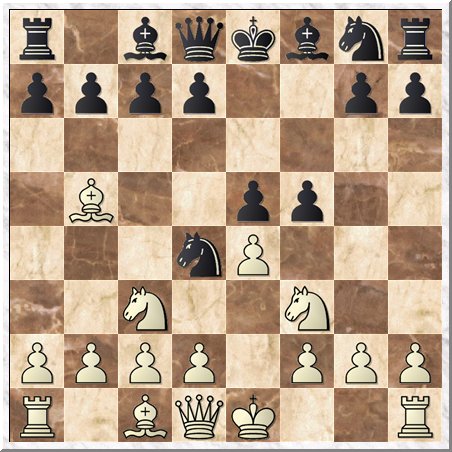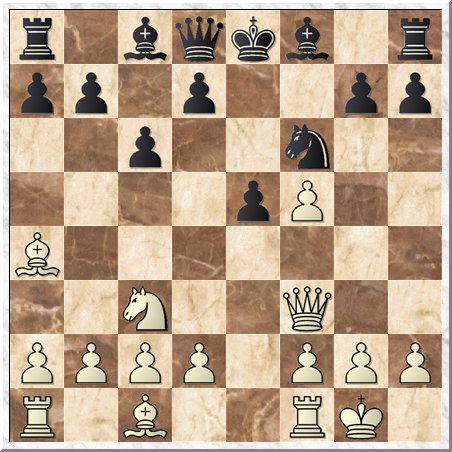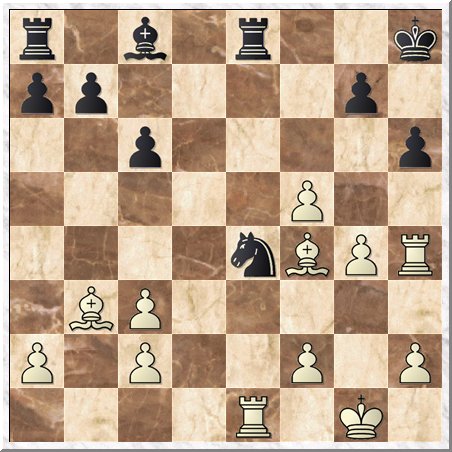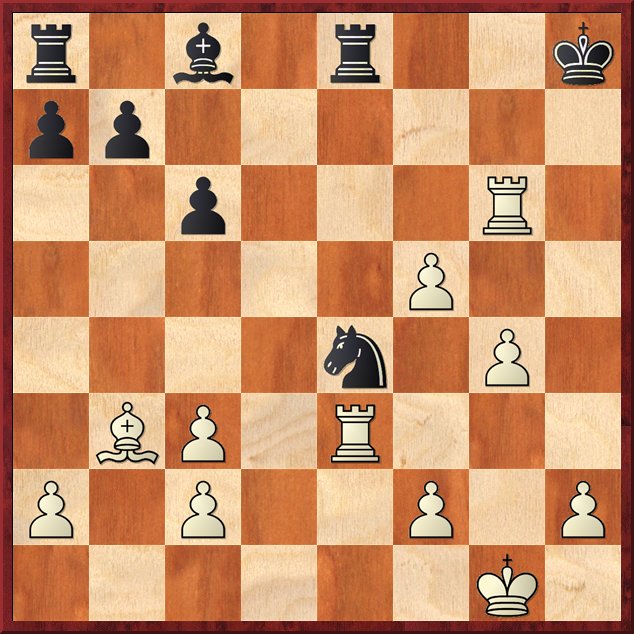All
the |
(Navigation bar
directly below.)
*******
© A.J. Goldsby, 2015.
(All rights reserved.)
****************
Click HERE
to see my
Chess Items.
****************
****************
Buy a book
from Amazon.com
(And help me out as well!)
****************
Click HERE
...
to see a list of the businesses that help to sponsor all of
my chess efforts.
CG
- "Problem of the Day"
(Wednesday;
April 3rd, 2013.)
Click HERE to see an explanation of the symbols that I commonly use when I annotate any chess game.
Click HERE to replay this game ... on another server.
Click HERE to go to my YT channel. ---> Click HERE to go to "You-Tube" ... and watch my video on this game.
NOTE: I wanted to get this game analyzed and get the game posted as soon as I saw it, which was just a few minutes after 11 PM on Tuesday evening. However, this turned out to be too difficult for me, as I wanted to do a reasonably thorough analysis. I wanted the game to be much more current, theoretically speaking, than any opening reference in existence. For this to be possible, I had to work about 20+ straight hours on the analysis. Then - of course - the real fun begins ... (the formatting of the web page, sometimes this has taken days ... or even weeks! ... of work to complete the project).
Actually, I began a web page on the Schliemann Defense over a year ago, and I worked several months on it. However, for some reason, I never finished that particular game ... or even began the web page. One of the beautiful things about ChessBase was that I was able to import all of that work into my analysis of this game. So actually, you are looking at the culmination of close to two years' worth of research and analysis into this opening.
GM Vitaly
Tseshkovsky (2525) - GM
Ventzislav Inkiov (2500)
|
|
|
[A.J. Goldsby I]
This was the "CG" POTD
("Problem of The Day") for
Wednesday; April 03rd, 2013.
(I thought that I would annotate it and place it on my website.)
-----> One of the main
reasons that I wanted to look at this game was that I have always had an interest in this opening.
(The Schliemann
Defence.)
1.e4 e5; 2.Nf3 Nc6; 3.Bb5 f5; 4.Nc3, (Center, development.)
This is not a poor move ... in fact, it is generally a good idea, as it conforms to all of the basic principles that govern correct opening play.
[ Several sources ... ECO, MCO and even the
new "PowerBook" ...
all give the following continuation here:
4.d3 fxe4; 5.dxe4 Nf6; 6.0-0 Bc5;
7.Nc3 d6; 8.Bg5 0-0; 9.Nd5,
"+/="
when White has a solid edge.
[ See MCO-15, page # 53; column # 30 and notes # (u.) through (w.) here. ]
MCO quotes a bizarre and rather vague game, I prefer to give the following struggle:
GM V. Anand (2817) - GM V. Ivanchuk
(2765);
4th Grand Slam Final / Sao Paulo, BRA / Bilbao,
ESP. / (R#3) / 28,09,2011.
{Black won a long and
an interesting fight, but the opening was not the culprit for White's
loss here.} ]
4...Nd4!?; (hmmm)
This is provocative and testy ... but I have to say that it looks somewhat suspect to me.
|
|
r1bqkbnr/pppp2pp/8/1B2pp2/3nP3/2N2N2/PPPP1PPP/R1BQK2R w KQkq - 0 5
The main problem that I
have with this line is that Black falls way behind in his overall development.
---> In this particular game, he never really gets things back to an even keel ...
[ The alternative was: (>/=)
RR 4...fxe4;
5.Nxe4 Nf6;
This is probably best.
(
Black appears to be getting destroyed after the
following continuation here:
5...d5; 6.Nxe5 dxe4; 7.Nxc6 bxc6; 8.Bxc6+ Bd7;
9.Qh5+ Ke7; 10.Qe5+ Be6; 11.Bxa8 Qxa8;
12.Qxc7+, '±'
when White is clearly on top.
(Some engines rate White's position as already winning.) )
We continue our examination of one of the main lines.
(In this continuation, the engines prefer 7.Neg5!, with an edge for White.
8...e4!?; is also interesting for Black.)
6.Qe2 d5!?; 7.Nxf6+!? gxf6;
8.d4 Bg7; 9.dxe5 0-0;
White is (temporarily) a Pawn ahead, and now the box recommends
10.e6!, "+/=" for White. (White would have a very small edge, but I am
sure that Black's position if fully viable.)
10.Bxc6 bxc6; 11.e6 Re8;
(Unclear, Black has two Bishops and a nice central pawn mass, while
White has the initiative ... and also a good pawn structure.
Houdini rates the position as being about equal.)
*** *** *** *** *** *** *** *** *** *** *** *** *** *** *** *** *** ***
The end of the column.
[ See MCO-15, page # 53; column # 25 and all notes.]
Now MCO gives Be3, while the obvious 0-0 must also be OK for White.
MCO quotes a game of GM L. McShane's, yet the following contest is
easily the most current game that I could find:
Yuriy Kryvoruchko (2666) - Andrey Zontakh
(2556); [C63, (Schliemann Def.)]
13th European Champ. {EU-ch 13th} / Plovdiv, BUL / (R#5)
/ 24,03,2012.
{White won a sharp and
interesting struggle, 1-0 in a total of 41 moves.} ]
5.exf5, (Waste of time?)
At first, this looks like a simple loss of tempo in a position where tempi are worth their weight in gold. Yet - in chess - sometimes things are NOT what they first appear to be, nor do superficial judgments hold up in master-level chess.
This is exactly in keeping with
one of the main ideas of many King-Pawn openings.
(This move may deserve an exclam, it is the first choice of many strong chess engines; it is
also the first move choice in the new "Power-Book.")
The basic concept at work here is that when you have a marked lead in your overall development, you should strive to open as many lines as quickly as possible.
[ I like to call this general
rule-of-thumb, "The (first) Morphy Principle." I so name it, because there
were several ideas that I learned when I went over all of Morphy's games when I
began to seriously study chess. IF you are really interested in learning the
fundamentals of the open game, there is no better way than learning from one
of the greatest chess minds that the game has ever produced. ]
[More
on Paul Morphy, Google him as well.]
[ White also stands well after:
5.Ba4,
"+/=" 5...Nf6;
(White is better, while Black
may have some play.) when the first player has several moves, (6.NxP/e5,
6.0-0, and 6.exf5); that all seem to leave White with a significant edge.
[ See MCO-15, page # 53; column # 28, and all notes. ]
A good game would be:
GM Anatoly Karpov (2695) - J. Manuel Bellon Lopez (2475);
Montilla, ESP; (R#2) / 1976.
{White won a very nice
squeeze, typical of Karpov's style ...
1-0 in 57 total moves.} ]
5...c6; (The question.)
Black tries to get White's LSB to back up, and does so with the gain of a tempo.
I found this game in an old chess book, and one annotator questioned it. I will only point out that it is the first choice of most chess engines ... and then move on.
[ After the continuation of:
RR 5...Nf6;
6.Nxd4 exd4; 7.Ne2, '±' ("+/"
White has an extra Pawn.)
White is clearly better, and it is not clear that Black can find adequate play
for the missing button. ]
6.Ba4 Nxf3+!?; (Doubtful?)
This does not look great - and one annotator gave it a whole question mark. Yet Black was already in some trouble, and there does not seem to be any easy way out for him.
[ The alternative would be:
(>/=) RR 6...d6;
7.0-0 Bxf5; 8.Nxd4 exd4; 9.Re1+,
"+/"
when it appears that White should win at least a Pawn.
(And maybe more.) ]
7.Qxf3 Nf6; 8.0-0, "+/"
The Informant - in a survey of the opening lines for that year - stops here and concludes that White is clearly much better.
|
|
r1bqkb1r/pp1p2pp/2p2n2/4pP2/B7/2N2Q2/PPPP1PPP/R1B2RK1 b kq - 0 8
After looking at the position, it
is difficult to argue with the Informant's rating of Black's opening play.
(White is a solid Pawn ahead, and Black's position remains congested and under-developed.)
8...d5; (Fundamentals.)
Black grabs some space and
also claims his fair share of the center, unfortunately, this is not enough to save his game.
{Too little ... too late?}
[ (or) After the continuation of:
RR 8...Be7;
9.Re1 d6; 10.Bb3, '±'
"+/"
White is also much better. ]
9.Re1 e4?; (Ugh!)
This is a horrible move, Black ignores his development and also practically begs White to open the game up.
If a student played this way,
I smack his hand ... (just kidding!) ...
but I do warn him that this is not the way to play such positions as Black.
In the reports of the tournament, apparently Inkiov used a lot of time early on and probably just "lashed out" here ... ... ...
[ Much better would have been the following line:
>/= 9...Qd6;
10.d3 Be7; 11.Bg5 0-0; 12.Bb3,
'±' ("+/")
when White is clearly better, (and has an extra pawn);
however, the game is a long way from being ...
"just an easy win" for the first player. ]
The next few moves - according
to the box - were all pretty much forced here.
(Black is already down one button - to go two pawns down, with virtually no play at
all, was pretty much hopeless.)
10.d3 Bb4!?;
11.dxe4 dxe4; 12.Bg5 0-0; 13.Rxe4!,
{D?}
White smashes on e4 and also hits the Black Bishop on b4.
[ </= 13.Nxe4!? Bxe1; "<=>" ]
Now Black creates a gash in White's Pawn structure ... he must have been counting on this one facet of the position to keep his chances alive and provide him with some much needed play. (Obviously 14.Qxc3, Nxe4; was not even possible.)
13...Bxc3; 14.bxc3 Qd6; (French fries - ketchup, anyone?)
Black races to catch up in his development, if 14...Kh8; then simply 15.g4, gives White a very comfortable game.
15.Bb3+ Kh8; 16.Rh4, ("Do you feel lucky?") [more]
Even if you have ice water in your veins, having White point all of his big guns at your King would make anyone nervous.
[ RR 16.Bf4; - Fritz 13. ]
16...Qe5; (Searching?)
Perhaps casting about and looking for play, Black thinks to attack White's pair of weak and doubled c-pawns.
[ RR 16...Nd5; 17.g4, "+/-" - Fritz 13 ]
Black is getting hammered here, he does not have a lot of choices in this position.
(Thus he decides to swap the ladies, perhaps in a vain hope to lessen the pressure.)
17.g4 h6; 18.Bf4 Qe4; 19.Qxe4 Nxe4; 20.Re1 Re8;
*** *** *** *** *** *** *** *** *** *** *** *** *** *** *** *** *** ***
Black has done all that he could ... but now White has a win ... based on many factors.
(A huge lead in development and the unsafe nature of Black's King - just to name
two facets of the field array.)
|
|
r1b1r2k/pp4p1/2p4p/5P2/4nBPR/1BP5/P1P2P1P/4R1K1 w - - 0 21
We have no reached the position for the POTD on the CG website. (Wednesday; April 3rd, 2013.)
White to move.
21.Bxh6!, (Correct!)
A "stock" combination, with all of White's artillery trained on the leader of the dark forces, a move
such as this flows naturally out of the position - just like a shining river running down to the sea.
[ White might also win here with g4-g5; below is just one sample variation:
</= 21.g5!? Bxf5;
22.f3! Nxc3?;
A natural looking move, suggested by one of my students that I asked to
look at this game.
( Much better was:
>/= 22...Nc5; 23.Be3 Kh7;
24.Kf2 Nxb3; 25.cxb3, '±' ("+/")
when - according to the engines - White has a win. Yet the
presence of opposite-colored Bishops ensures that Black
will probably be able to put up some decent resistance.
)
23.Be5!, +-
("+/-" White wins.)
when the first player has an overwhelming advantage.
***** ***** ***** ***** ***** ***** ***** ***** ***** ***** ***** ***** ***** ***** *****
RR
White also wins with: 21.f3!? Nf6;
22.Be5 Kh7; 23.g5 Nd5;
24.f6, "+/-"
when all the machines, engines and programs agree ... White is winning easily.
---> This line added: 04/19/2013. ]
Black had to capture, if not ... he is going down three pawns for nothing.
Not only this, White also is threatening to move the Bishop on h6 and call mate.
21...gxh6[]; 22.Rxh6+ Kg7; 23.Rg6+ Kh8; {Diagram?}
It no longer really mattered what Black played here, nothing was going to save this shipwreck.
[ It would be useless to try this line here:
</= 23...Kf8?;
24.Rg8+ Ke7; 25.Rxe4+ Kd6; 26.Rexe8,
"+-" (Extra Rook.)
when there is no real point in Black continuing the game.
***** ***** ***** ***** *****
Or >/= RR 23...Kh7;
24.Re3 Nxf2T;
The box shows that this was the only move here for Black.
25.Bg8+! Kh8[]; Forced.
( Or </= 25...Rxg8?!; 26.Re7+ Rg7;
27.Rexg7+ Kh8; 28.f6, "+/-"
and Black will be mated. )
26.Rxe8, "+/-" (+12.38)
when most players (playing Black) would probably resign, rather than play on.
]
24.Re3, "+/-" Black Resigns.
The handwriting is on the wall, at least Black had the good sense to call it quits before White subjected him to a rather simple "edge-of-the-board" checkmate.
A nice game by White, although Black did not make the best choices at several key intervals.
The final position, (below).
|
|
r1b1r2k/pp6/2p3R1/5P2/4n1P1/1BP1R3/P1P2P1P/6K1 b - - 0 24
Copyright (c) A.J. Goldsby, 2013. All rights reserved.
1 - 0
More Resources
-
GM Viswanathan Anand and GM Magnus Carlsen play to a tough draw in 2008, the ECO/Informant code is E63.
-
My web page on the game, Barry vs. Marshall from Cambridge Springs, 1904. (Another look at the Schliemann.)
-
The CG web page for the Schliemann Defense. (Many good links!)
-
My web page on the game between Reti and Capablanca from (Berlin) 1928. (It's not a true Schliemann, but the Siesta Variation, which is a closely related/similar opening. If you are interested in really learning the Schliemann, then the Siesta might also be an opening system that you would also like to study as well. Capa also used this opening vs. Steiner, click HERE to see/play over that particular sharp (& historic} game. A NY Times article on this opening - which features the following game.)
The
analysis for this page was prepared with the excellent program,
ChessBase
10.0.
(My main analysis engines were Fritz 13, Houdini 1.5 and also
the latest version of Deep Shredder.)
The
HTML was polished with several different tools and programs, (mostly
FP) ... the text was checked for spelling with MS
Word.
(Note that I no longer have the use of "Chess
Captor" as I have upgraded to Windows 7.)
|
Go ... or return ... to my Home Page for this site. Go (or return) ... to my "Annotated Games" (II) Page. Go
... or return ... to my "Best Games" Page. *******
Copyright (c)
LM A.J. Goldsby
I *******
This
page was first generated in: (early)
April, 2013. (Posted
on Tuesday; April 9th, 2013.) |



